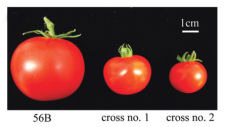Tomatoes that trick taste buds
Eating these lab-grown treats can make sour foods taste really sweet
Be careful if you ever decide to eat a tomato grown in the laboratory of Kazuhisa Kato and his colleagues. You might get more than you bargained for, and afterward, things might not taste the same.
In the garden, tomatoes grow like fruit. In the kitchen, chefs treat tomatoes like vegetables. And now, Kato and his colleagues have found a way to make ‘maters even more confusing. Kato’s tomatoes have been engineered to change an eater’s sense of taste. For about an hour after a person eats one of these morsels, sour foods will taste sweet.

The key ingredient to Kato’s taste-shifting tomatoes is called “miraculin.” That word sounds like “miracle,” which might refer to its unusual power. Miraculin is a kind of biological molecule called a glycoprotein — a protein like those in our bodies, and with a carbohydrate molecule attached. Miraculin is found in berries growing on shrubs that mainly flourish in a part of West Africa. These fruits are sometimes called (and sold as) “Miracle Fruit” berries.
People have long known about the ability of miracle berries to alter taste buds. In some countries, the berries are used as a way to help people lose weight. For example, a dieter could eat a berry and then snack on low-calorie sour foods that would taste wonderfully sweet.
Scientists identified the miracle berry’s glycoprotein for the first time in 1968. Since then, people have wondered how to make a lot of it. One way could be to harvest berries from the plants; but if demand gets too large, the plants could be driven to extinction.
That’s where Kato and other researchers come in. They have been looking at DNA. Inside almost every cell of every living organism are chromosomes, and chromosomes are made of DNA, a coiled molecule that contains the set of directions for how to make the proteins that make life possible.
A gene is a unique segment of DNA that can direct the cell to build a specific protein. The miracle berry has a gene that contains the instructions for how to make miraculin.
Kato and his colleagues inserted the gene for miraculin into the genetic code of a tomato. As a result, cells in the tomatoes made miraculin. Those tomatoes had just as much miraculin as miracle berries do. These “miracle” tomatoes could be grown in large numbers, protected indoors. If scientists can grow other foods with miraculin inside, then there won’t be any need to harvest all the miracle berries.
The researchers don’t know yet how the tomato-based miraculin can be used. Perhaps it could be sold as a dieting aid, to be taken before meals.
In any case, be vigilant on Halloween, especially if someone gives you a lemon and it tastes like lemonade. It might be more trick than treat.
POWER WORDS (adapted from the Yahoo! Kids Dictionary)
gene A hereditary unit consisting of a sequence of DNA that occupies a specific location on a chromosome and can determine a particular characteristic in an organism.
DNA A molecule, shaped like a spiral staircase, that carries the genetic information stored in genes and chromosomes.
miraculin A glycoprotein found in the miracle berry, Synsepalum dulcificum.
protein Fundamental components of all living cells and include many substances, such as enzymes, hormones, and antibodies, that are necessary for the proper functioning of an organism.







